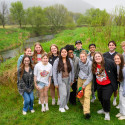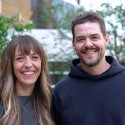Writer’s Choice: Chazen exhibit illuminates ‘Hidden Treasures’

Vincent Raymond de Lodève (1535–57), Initial ‘O’ with St. Clement I Pope and Martyr from Sistine Chapel Antiphonary, 1539. Courtesy: Chazen Museum of Art
Before the printing press was invented in the 15th century, books were handwritten on parchment and painted with brilliant pigments and metals. The miniature paintings, called illuminations for the frequent use of shimmering gold leaf, are still breathtakingly vibrant today.
Produced in Western Europe during the Middle Ages and early modern period, illuminated manuscripts represent the convergence of medieval bookmaking, the written word and art.
Now, a once-in-a-lifetime exhibition at the Chazen Museum of Art brings together approximately 40 illuminated manuscripts and single leaves, dating from the 9th to 16th century.
Hidden Treasures: Illuminated Manuscripts from Midwestern Collections runs through Feb. 27 in the Chazen’s Mayer Gallery.
Curator Maria Saffiotti Dale gathered these ornate handmade works from 16 Midwestern sources in seven states: university libraries, museums, and private collections. Examples include bibles, liturgical manuscripts, devotional books for private use, and volumes containing literary, historical and legal texts.
“We have a good representation of most of the Middle Ages, which is a very long period of history,” said Saffiotti Dale in a recent Wisconsin Public Radio interview. (The interview, originally aired during a broadcast of Sunday Afternoon Live at the Chazen, is available online to supplement the Chazen’s gallery guide.) “The earliest is a fragment of a giant Bible from Tours in France, and the latest is a small devotional prayer book made for a cardinal archbishop in Brussels in the very end of the 16th century.”
Because these images have been preserved within closed book covers, the colors remain bright and the metallic shimmer continues to reflect the light that gave the art its name.
The idea of illumination has multiple meanings. Made with burnished gold leaf, the books reflect their surroundings: usually the dim glow of candles in a church or private study.
“Candlelight reflecting off of gold leaf illuminates, literally gives light, to the image and to the book it is contained within,” said Saffiotti Dale. “But, also, illumination refers to the spiritual illumination of the word of God.”
Full-page miniatures often highlight the main theme of a book. In one missal, a crucifixion scene emphasized not just the central role of Christ’s sacrifice but echoed those who had commissioned the work: a German monastery called Heiligenkreuz, or Holy Cross. The detail adds personal resonance.
“You have included, at the base of the cross, a tiny figure who is one of the members of the religious community for which this book was made, around 1300,” said Saffiotti Dale. “It’s a very interesting and poignant image; it would have been particularly poignant to those members of the Dominican order for which this book was made, and who used this book.”
Secondary decoration, such as major initials, also served a purpose: signaling themes and sections within a book. In some cases, the large initials featured scenes referring to a feast day described in the text. In others, flowers and leaves served as place markers.
These visual embellishments added beautiful detail that emphasized the luxury of having access to such a work. Saffiotti Dale specifically highlights Netherlandish and French Books of Hours, included in the exhibition.
“But [embellishments] also can have symbolic meaning,” she said. “The choice of the particular flowers, if there are particular animals, or even little narrative scenes going on in the borders — there’s always a meaning that can be attached to it.”
During the Gothic period, between the 12th and 15th centuries, the margins often contained scenes of human/animal hybrids — images featuring human and animal elements combined, as well as animals engaged in human activities. These sometimes served as puns or commentary. In one representation of the Gospel of Mark, a playful human-animal figure of a bishop (supposedly chaste) listens to a woman playing the psaltery. This may refer to the “animal nature” of humans as compared to the ideal of Christ.
Several examples in this exhibit highlight the creation of these beautiful works. An unfinished French Book of Hours from the Memorial Library’s own collection shows the order in which the artists planned to fill in scenes from the Nativity.
However, the exhibition also discusses the destruction and separation of many illuminated items. Many complete manuscripts were torn apart by collectors, especially after a large number of monasteries dissolved in the 1700s.
On Thursday, Feb. 17, Roger Wieck, curator of medieval and Renaissance manuscripts at New York’s Morgan Library & Museum, will present a lecture titled “Folia Fugitiva: The Pursuit of the Illuminated Manuscript Leaf” at 5:30 p.m. in Room L140 of the Chazen.
Wieck’s lecture traces the history of collecting individual folios sliced from illuminated manuscripts, From Napoleon’s looting of the Sistine Chapel to modern sales on eBay, this phenomenon refocused the symbolism of these manuscripts from religious to capitalist. In twentieth-century America, the practice continued under such men as Otto Ege, of the Cleveland Institute of Art, who cut up manuscripts for educational purposes.
Editor’s note: Artist demonstrations rescheduled: Guest artist Valerie Weilmuenster, a manuscript illuminator from the Chicago area, will demonstrate the time-honored techniques for painting sacred manuscripts including paint mixing, painting decorated letters, and gilding. The demonstrations, originally scheduled for Jan. 28–30, will take place on the second floor of the museum during the following times: Friday, Feb. 18: 9 a.m.–1 p.m. and 2–4:45 p.m.; Saturday, Feb. 19: 11 a.m.–2 p.m. and 2:30–4:45 p.m.; and Sunday, Feb. 20: 11 a.m.–1:30 p.m. and 2–4:45 p.m.
The Chazen Museum of Art is located at 800 University Ave. Please note: The south (University Avenue) entrance will be closed until June. Admission is free during regular museum hours; the museum is open to the public Tuesday through Friday from 9 a.m.- 5 p.m. and weekends from 11 a.m.–5 p.m. (closed on Mondays). For additional information about Chazen exhibitions, contact staff at 263–2246.




